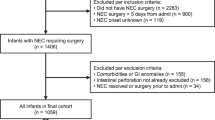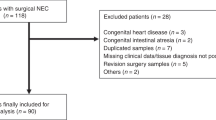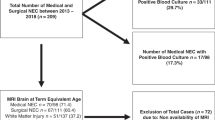Abstract
Objective:
This investigation tests the hypothesis that the clinical presentation and the outcome of necrotizing enterocolitis (NEC) vary with gestational age (GA).
Methods:
All infants admitted to our center between October 1991 and September 2003 were evaluated weekly to identify confirmed cases of NEC. Based upon GA, these infants were divided into five groups: Extremely premature (EP, 23 to 26 weeks), very premature (VP, 27 to 29 weeks), moderately premature (MP, 30 to 34 weeks), near-term (NT, 35 to 36 weeks), and term (T, 37 to 42 weeks).
Results:
A total of 202 infants developed NEC. The most common sign of NEC among EP infants was ileus (77%), followed by abdominal distention (71%), emesis (58%), pneumoperitoneum (54%), fixed intestinal loop (52%), gasless abdomen (42%) and bloody stools (17%). Intramural gas was detected in 100% of T but was present in only 29% of EP infants (P<0.0001). Similarly, portal venous gas was common in T but infrequent in the EP infants (47 vs 10%, P<0.0001). Despite a higher peritoneal drain insertion rate (31 vs 5%, P<0.001) and a higher mortality rate (33 vs 10%, P=0.05) in EP compared to T infants, other clinical outcomes were not different.
Conclusions:
The clinical presentation of NEC is different in EP compared to more mature infants; however, outcome among NEC survivors is similar across all GA. Reliance solely on observation of intramural or on portal venous gas in EP infants may lead to a delay or failure in the diagnosis.
This is a preview of subscription content, access via your institution
Access options
Subscribe to this journal
Receive 12 print issues and online access
$259.00 per year
only $21.58 per issue
Buy this article
- Purchase on Springer Link
- Instant access to full article PDF
Prices may be subject to local taxes which are calculated during checkout


Similar content being viewed by others
References
Sangild PT, Petersen YM, Schmidt M, Elnif J, Petersen TK, Buddimgton RK et al. Preterm birth affects the intestinal response to parenteral and enteral nutrition in newborn pigs. J Nutr 2002; 132: 2673–2681.
Diehl-Jones WL, Askin DF . Nutritional modulation of neonatal outcomes. AACN Clinical Issues 2004; 15: 83–96.
Nanthakumar NN, Fusunyan RD, Sanderson I, Walker WA . Inflammation in the developing intestine: a possible pathophysiologic contribution to necrotizing enterocolitis. Proc Natl Acad Sci USA 2000; 97: 6043–6048.
Clark DA, Miller MJ . Intraluminal pathogenesis of necrotizing enterocolitis. J Pediatr 1990; 117: S64–S67.
Nanthakumar NN . The regulation of functional development of the small intestine In: Delvin E, Lentze MJ (eds) Gastrointestinal Functions. Nestle Nutrition Workshop Series 4. Lippincott Williams and Wilkins: Philadelphia, 2001,; 39–58.
Berseth CL . Gut motility and the pathogenesis of necrotizing enterocolitis. Clin Perinatol 1994; 21: 263–270.
Sharma R, Hudak ML, Premachandra BR, Stevens G, Monteiro CB, Bradshaw J et al. Clinical manifestation of rotavirus infection in the neonatal intensive care unit. Pediatr Infect Dis J 2002; 21: 1099–1105.
Walsh MC, Kliegman RM . Necrotizing enterocolitis: treatment based on staging criteria. Pediatr Clin N Am 1986; 33: 179–201.
Bell MJ, Ternberg JL, Feign RD . Neonatal necrotizing enterocolitis: therapeutic decisions based upon clinical staging. Ann Surg 1978; 187: 1–7.
Alexander G, Hulsey TC, Smerigilo VL, Comfort M, Levkoff A . Factors influencing the relationship between a newborn assessment of gestational maturity and the gestational age interval. Paediatr Perinat Epidemiol 1990; 4: 133–146.
Ballard J, Khoury JC, Wedig K, Wang L, Eilers-Walsman BL, Lipp R . New Ballard Score, expanded to include extremely premature infants. J Pediatr 1991; 119: 417–423.
Sharma R, Tepas III JJ, Mollitt DL, Pieper P, Wludyka P . Surgical management of bowel perforation in very-low-birth-weight infants (<1200 g). J Pediatr Surg 2004; 39: 190–194.
SAS Institute Inc. SAS User's Guide, version 9.2. Cary, NC, 2002.
Kliegman RM, Walsh MC . Pathophysiology and epidemiology of necrotizing enterocolitis. In: Polin RA, Fox WW (eds). Fetal and Neonatal Physiology. Saunders: Philadelphia, PA, 1992, pp 1078–1084.
Neu J, Chen M, Beierle E . Intestinal innate immunity: how does it relate to the pathogenesis of necrotizing enterocolitis. Semin Pediatr Surg 2005; 14: 137–144.
Bjornvad CR, Schmidt M, Petersen YM, Jensen SK, Offenberg H, Elnif J et al. Preterm birth makes the immature intestine sensitive to feeding-induced intestinal atrophy. Am J Physiol Regul Integr Comp Physiol 2005; 289: R1212–R1222.
Sanderson IR . The physicochemical environment of the neonatal intestine. Am J Clin Nutr 1999; 69 (Suppl): 1028S–1034S.
Meetze WH, Palazzolo VL, Bowling D, Behnke M, Burchfield DJ, Neu J . Meconium passage in very-low-birth-weight infants. J Parenter Enteral Nutr 1993; 17: 537–540.
Neu J, Koldovsky O . Nutrient absorption in the preterm neonate. Clin Perinatol 1996; 23: 229–234.
Lima-Rogel V, Calhoun DA, Maheshwari A, Torres-Montes A, Roque-Sanchez R, Garcia MG et al. Tolerance of a sterile isotonic electrolyte solution containing select recombinant growth factors in neonates recovering from necrotizing enterocolitis. J Perinatol 2003; 23: 200–204.
Sharma R, Tepas III JJ, Hudak ML, Wludyka PS, Mollitt DL, Garrison RD et al. Portal venous gas and surgical outcome. J Pediatr Surg 2005; 40: 371–376.
Salle B, Picaud JC, Lopilloune A, Claris O . Mortality and morbidity of low-birth-weight infants. Current prognosis and future perspectives. Bull Acad Natl Med 2004; 188: 1127–1139.
Acknowledgements
This work is dedicated to the memory of Jim A Bradshaw, MD, Department of Radiology, University of Florida at Jacksonville.
Author information
Authors and Affiliations
Corresponding author
Additional information
Presented at the 37th Annual Meeting of the Canadian Association of Paediatric Surgeons, Québec City, Québec, Canada.
Rights and permissions
About this article
Cite this article
Sharma, R., Hudak, M., Tepas, J. et al. Impact of gestational age on the clinical presentation and surgical outcome of necrotizing enterocolitis. J Perinatol 26, 342–347 (2006). https://doi.org/10.1038/sj.jp.7211510
Received:
Revised:
Accepted:
Published:
Issue Date:
DOI: https://doi.org/10.1038/sj.jp.7211510
Keywords
This article is cited by
-
Gestational age-specific hematological features in preterm infants with necrotizing enterocolitis
Pediatric Research (2024)
-
Outcomes by disease onset, sex, and intervention in neonates with SIP and surgical NEC
Pediatric Research (2023)
-
Fecal amine metabolite analysis before onset of severe necrotizing enterocolitis in preterm infants: a prospective case–control study
Scientific Reports (2022)
-
Hypoxic/ischemic hits predispose to necrotizing enterocolitis in (near) term infants with congenital heart disease: a case control study
BMC Pediatrics (2020)
-
International evidence-based guidelines on Point of Care Ultrasound (POCUS) for critically ill neonates and children issued by the POCUS Working Group of the European Society of Paediatric and Neonatal Intensive Care (ESPNIC)
Critical Care (2020)



